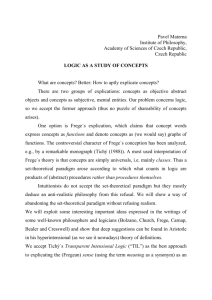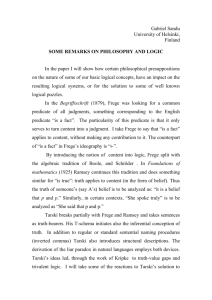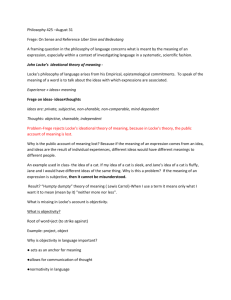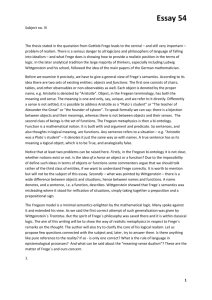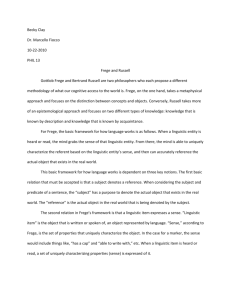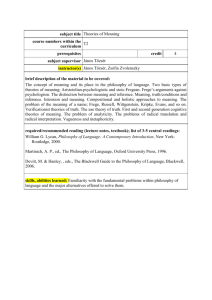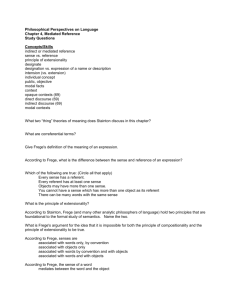Phil 5430, A02—Week 1 notes
advertisement
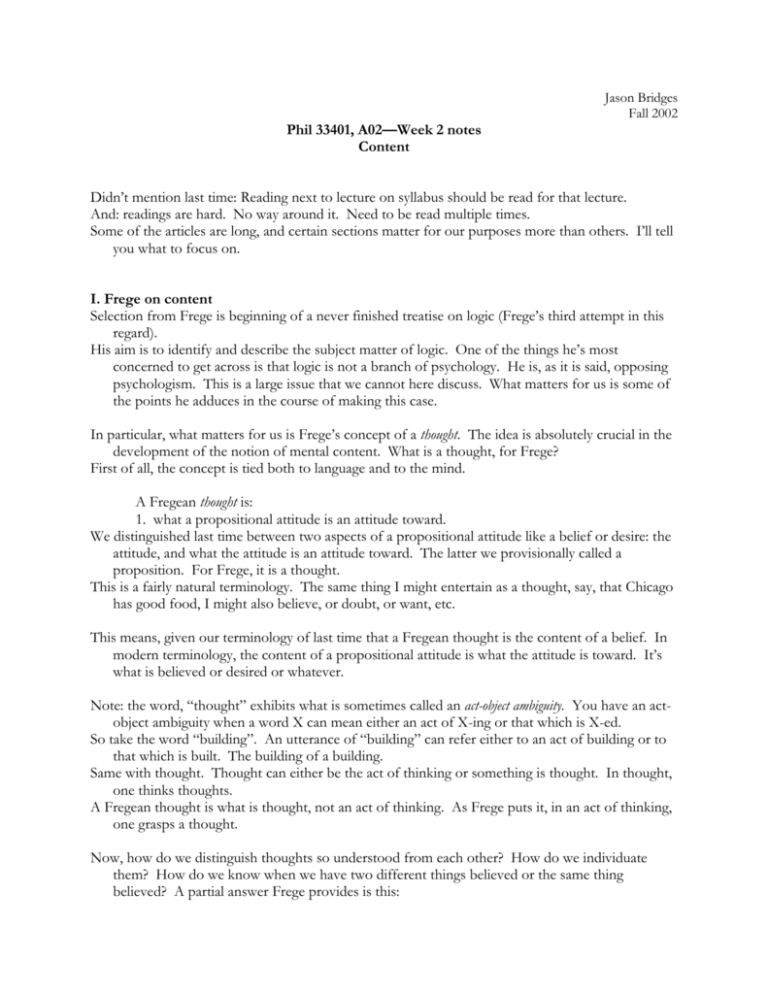
Phil 33401, A02—Week 2 notes Content Jason Bridges Fall 2002 Didn’t mention last time: Reading next to lecture on syllabus should be read for that lecture. And: readings are hard. No way around it. Need to be read multiple times. Some of the articles are long, and certain sections matter for our purposes more than others. I’ll tell you what to focus on. I. Frege on content Selection from Frege is beginning of a never finished treatise on logic (Frege’s third attempt in this regard). His aim is to identify and describe the subject matter of logic. One of the things he’s most concerned to get across is that logic is not a branch of psychology. He is, as it is said, opposing psychologism. This is a large issue that we cannot here discuss. What matters for us is some of the points he adduces in the course of making this case. In particular, what matters for us is Frege’s concept of a thought. The idea is absolutely crucial in the development of the notion of mental content. What is a thought, for Frege? First of all, the concept is tied both to language and to the mind. A Fregean thought is: 1. what a propositional attitude is an attitude toward. We distinguished last time between two aspects of a propositional attitude like a belief or desire: the attitude, and what the attitude is an attitude toward. The latter we provisionally called a proposition. For Frege, it is a thought. This is a fairly natural terminology. The same thing I might entertain as a thought, say, that Chicago has good food, I might also believe, or doubt, or want, etc. This means, given our terminology of last time that a Fregean thought is the content of a belief. In modern terminology, the content of a propositional attitude is what the attitude is toward. It’s what is believed or desired or whatever. Note: the word, “thought” exhibits what is sometimes called an act-object ambiguity. You have an actobject ambiguity when a word X can mean either an act of X-ing or that which is X-ed. So take the word “building”. An utterance of “building” can refer either to an act of building or to that which is built. The building of a building. Same with thought. Thought can either be the act of thinking or something is thought. In thought, one thinks thoughts. A Fregean thought is what is thought, not an act of thinking. As Frege puts it, in an act of thinking, one grasps a thought. Now, how do we distinguish thoughts so understood from each other? How do we individuate them? How do we know when we have two different things believed or the same thing believed? A partial answer Frege provides is this: Intuitive criterion of difference: Thoughts differ if a competent adult can take conflicting attitudes toward them at the same time without thereby being irrational. [That’s Gareth Evans’ term for it.] So if I can believe thought a and simultaneously reject thought b without being guilty of irrationality, they are different thoughts. Consider Frege’s example. Dr. Gustav Lauben says, “I was wounded.” Rudolph Lingens hears him say so. The next day Leo Peter says to Rudolph Lingens, “Dr. Lauben was wounded.” Do Lauben’s and Peter’s utterances express the same thought? It might seem like they do, given they predicate the same property of the same object. But suppose Lingens doesn’t know that the guy who spoke earlier is Lauben; he thinks he’s someone else. Moreover, he believes Lauben never saw combat…. So he believes that… but not that…. Is her irrational? Clearly not. So, Frege says, we have to distinguish thoughts here. Even though both thoughts ascribe the same property to the same object, they are different thoughts, for a rational person could readily take opposing attitudes towards them. This is only a partial account of what individuates thoughts. It only gives a criterion for when they differ—it doesn’t specify conditions in which two different expressions of a though express the same thought. 2. The sense of an assertive utterance. An assertive utterance is, of course, an utterance that states something to be so (as opposed to one that issues a command or asks a question). E.g., assertions of: The sky is blue. Everyone knows that Chicago has good food. Now, what “sense” means for Frege is roughly “meaning”. But the concept of linguistic meaning is very complex and multifaceted. The notion of sense is intended to capture one kind of thing we might mean when we talk about meaning. We could spend a whole course on this—I can provide only the roughest outline of what is at stake here. One crucial distinction is between sense and reference. Reference is a relation that holds between a linguistic expression and an individual thing. To say that a word refers to an individual is to say that it stands for it. The name, “Aristotle”, refers to, stands for, the man Aristotle. In the case of some expressions, e.g., “that doughnut”, what is referred to varies from utterance to utterance. In such a case the reference of the expression is said to be context-dependent. “Here” is another example of context-dependent reference. In one of its uses, “here” may be understood as referring to place where the speaker is located (or sometimes, pointing or otherwise indicating). Now, certain expressions obviously have the job of referring to things. Proper names, demonstrative expressions. Frege claimed, and many have followed him in this, that there is a general notion of reference that has application to a much wider range of expressions. E.g., in the sentence above, “blue” might be taken to refer to the property of being blue or something in that neighborhood. Frege even felt whole assertive utterances have references. In particular they refer to truth-values. True assertions refer to “the true”, as Frege would put it. Why any of this should be thought to be so is a question for the philosophy of language, the theory of meaning, and we will not discuss it at all. So let’s stick with obvious cases of reference: “that doughnut” Suppose I say, “that doughnut looks tasty”, and you say “that piece of junk food looks sickening” and we’re both pointing to the same thing. So these noun phrases on our respective lips have the same reference, refer to the same thing. We might even put this by saying that we both meant the same thing. (Example illustrating this locution.) So talking about reference captures a genuine facet of meaning. But is it the only facet? It would seem clearly not. There’s an obvious sense in which “that doughnut” and “that piece of junk food” don’t mean the same thing. “Doughnut” doesn’t mean the same as “piece of junk food”; at the very least its meaning is more specific. The respect in which the meanings of these phrases differ Frege calls their sense. They are the same in reference, but differ in sense. That’s pretty vague—sense is the kind of meaning that’s not the same in these cases. Can we say anything more to pin it down? Frege does, as is already implied by my 1 and 2. Frege’s idea is that the sense of a whole (declarative) utterance is the thought the utterance expresses, in the sense of what a person who believed the utterance would thereby believe. The sense of a subsentential expression is then the contribution that expression makes to the thought an utterance of the sentence expresses. This allows us to capture the idea just expressed earlier, that expressions that refer to the same object can differ with respect to this other kind of meaning, sense. Suppose we hypothesize that the contribution of expressions like demonstrative phrases and names to the thoughts expressed by utterances of sentences of which they are a part is simply that they stand for or refer to the object that they do. That’s their contribution to the thought: they refer to an object, of which some property can then be predicated. But this would entail that co-referring expressions make the same contribution to the thoughts expressed by the sentences to which they belong. E.g., “That guy,” and “X” refer to the same person. So “X is a grad student” and “That guy is a grad student” would have to express the same thought. But by Frege’s criterion, they don’t. Elaborate…. So it follows that the contribution to thought-determination made by these expressions cannot be the same, and so cannot be simply a matter of what they refer to. They must have some further property, above and beyond their referring to what they do, and it must differ. This is what Frege calls the sense of an expression. 1 and 2 coupled with the intuitive criterion of difference are the basic tenets of a view about meaning that has come to be called Fregean semantics. The most salient feature of this semantics for our purposes is that it identifies the meaning of an utterance (in one sense of meaning) with a potential content of a belief or other propositional attitude. So utterance meaning is identified with mental content. More specifically: Meaning-content identity: The meaning (sense) of an assertion is identical to the content of the belief the assertion expresses. When I say, “Chicago has good food,” what that sentence on my lips means (in one sense of meaning) is also the content of the belief that I express That means that various conclusions we draw about the meanings of various utterances can have direct implications for the contents of thoughts and beliefs. That will prove of fundamental importance in what is to come. Now, it should be noted that not everyone accepts Fregean semantics. And they reject different things. Some deny that Fregean thoughts are either the meanings of sentences or the contents of propositional attitudes. Rather they point to what is nowadays called a ‘proposition’. Propositions have many of the features Frege ascribes to thoughts, but they’re individuated, not in terms of what a rational subject’s attitudes can be toward the items in question, but rather in terms of ideas drawn from possible-worlds semantics. Propositions are sets of possible worlds, or some variant of that idea. Such philosophers needn’t reject meaningcontent identity thesis. But some reject meaning-content identity. They think that the meaning of an utterance is one thing, the content of the expressed belief another. This may seem a rather bizarre view, but you may all find it much more appealing once we turn to Putnam’s and Burge’s twin-Earth cases. We’re not gonna be able to compare the Fregean apparatus to others. That would be a whole different course. But nor am I going to assume the details of the Fregean view in what is to come. The important points to keep in mind are: 1. The content of a propositional attitude is what the attitude is an attitude toward. 2. Content so understood is related to the meanings of the sentences we use to express our attitudes, perhaps by identity, perhaps in some other less direct way. Moreover, it’s important to keep in mind that the notion of meaning that has that connection is not reference. In particular, one can distinguish between, say, “that guy” and “X” on my lips. Maybe it’s sense, with its connection to the intuitive criterion of difference, maybe it’s something else. II. Intentionality Related to this issue is the crucial notion of intentionality. Sometimes content in the sense we’re talking about is called “intentional content”. And I want to say a quick word about this. Chisholm introduced the term into the English language, prompted by some work of the late 19th century German philosopher Brentano. Brentano identified a phenomenon of “intentionality” and claimed that it was distinctive of the mental. “Intentionality” is a technical term; it is not especially connected to the idea of an intention (although intentions will be among the mental phenomena that exhibit intentionality). Another phrase for it, Brentano says, is ‘directedness’ toward an object. What is distinctive of mental phenomena, for Brentano, is that they’re directed toward objects. Another way to put the idea is that mental phenomena, but not physical phenomena, are of or about or toward something. My fear of spiders is a fear of something, namely, spiders. Spiders are not themselves of anything in this sense. My belief that the sun is hot is about the sun, but the sun is not itself about anything. My anger is directed toward you, but you are not in this sense directed toward anything. Now, prepositions have loads of meanings/uses, as anyone attempting to learn a foreign language knows when they try to map uses of the prepositions of one language onto another. So it’s not as just using these three prepositions is supposed to fix the idea of intentionality. It doesn’t, for the simple reason that these prepositions have unrelated uses. (You are the daughter or son of someone; that doesn’t mean you have intentionality.) So what matters hear is the particular examples we’re using. They’re all supposed to exhibit rather clearly a common feature. Call it directedness, aboutness, intentionality. Now, we may not agree that all mental items have intentionality (e.g., pains). But propositional attitudes do. Chisholm refined the idea. In particular, he characterized what he called the “intentional” use of language. And he claimed that ascriptions of propositional attitudes must use language in this way. This in turn led to the term, “intentional content”. The major feature of the intentional use of language is nowadays called substitution failure. One such failure is a failure of substitution of co-referential referring expressions. Ordinarily, coreferential referring expressions are intersubstitutable salva veritate, i.e., saving truth. If you have a sentence and replace a referring expression in it with an expression that refers to the same thing, you get a sentence with the same truth value. For example: X is a grad student. That guy is a grad student. (said pointing at that guy.) The former is true, and so is the latter. But now consider these two sentences: Y believes that X is a grad student. Y believes that that guy is a grad student. Here we may well have a divergence in truth value. Or consider a famous example: Hesperus and Phosphorous…. This failure of substitutability is one of the things distinctive of intentional uses of language. Note that sometimes when we are talking about the purely linguistic phenomenon, as opposed to the ‘metaphysical’ idea of intentionality this word is used instead: “intensional”. The part after the phrase “Y believes that” is an intensional context. Analogously “that”-clauses in propositional attitudes exhibit a failure of substitution of coextensional predicates. The extension of a predicate is the group of objects that that predicate is true of. The extension of the predicate “is blue” is the class of blue things. The extension of “is a wolf” is the class of wolves. Ordinarily co-extensional predicates are intersubstitutable salva veritate. If you have a sentence and replace a predicate in it with a predicate with the same extension, you get a sentence with the same truth value. Take some terms coined by Quine. A “renate” is a creature with a kidney. A “cordate” is a creature with a heart. As it happens these terms are co-extensional. So: Bob is a cordate. Bob is a renate. The former is true, and so is the latter. But consider: Y believes that Bob is a cordate Y believes that Bob is a renate. These needn’t have the same truth-value. Since content is what is expressed by a “that”-clause in an ascription of a propositional attitude, the fact these clauses are intentional uses of language suggests the usage, “intentional content”. These substitutional failures are obviously related to the difference between reference and meaning (sense). Intensionality embodies in yet another way the fact that content is more “fine-grained” than reference.
